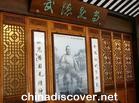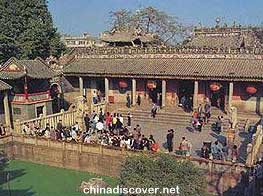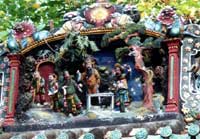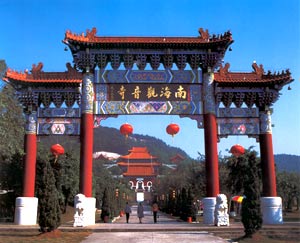Foshan Xishan Temple
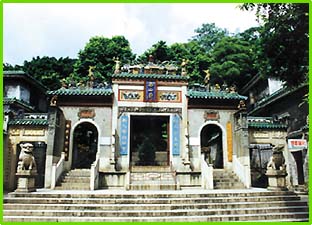
Foshan Xishan Temple is one of the most important historical cultural relic of China that protected by Guangdong province. The temple was built during the Jiajing Period in the Ming Dynasty (1541), reconstructed and expanded afterwards.
It was known as Guandi Temple originally, as built in the foot of a mountain of Western Hills in the county town, so commonly called Western Hills temple, in chinese Xishan temple. Its major buildings are arrayed along the vertical axial line and divided into front door, antetemple and main temple, with total area of about 6000 square meters.
magnificent front door
The temple's front door is so magnificent that as wide as five rooms, with the top ridge decorated with double-sided paintings of Shiwan pottery, all of which are originated from the stories of the "Historical Novel of Three Countries" and carved with primitive and vivid figures. Furthermore, on the top of the front door hangs a piece of gold-lacquered woodcarving upright plaque named as "Xishan Temple", at the both sides of the door, there are two pottery statues named as "two dragons playing one pearl", which were carved by Shiwan's Wenyian Society in late Qing Dynasty; at the bottom of the door there are brick statue named as "thirsting for wisdom at Weishui River", and grouped paintings of kylin and phenix.
The unique woodcarving couplet
Nearby the door hangs pair of gold-lacquered woodcarving couplet: "wishing the Heaven blessing good persons, wishing good persons doing good "
The antetemple and major temple are constructed by rigid collar beam, with a composite structure of girders and gates.
Marvelous Decorations
The penthouse board of the major temple was decorated with flowers, grass, characters and woodcarvings, etc, as well as dragon-like corner kist. The principal columns are either square or circular, with its construction materials of both woods and stones. And, the stone columns are provided with bamboo-like, prismatic and circular decorations, etc. The column base has shroud, corrugated, square and door-like forms.
On the round pole of the main temple carved a pair of couplet in Guangxu period of Qing Dynasty: "this old city is equipped with three city doors, and his Holy Spirit of Guandi is protecting the left one; Guandi is worshipped forever, and his attendants are also respected". The first line of the couplet refers to that ancient Shunde had only east, south and north doors, and Guandi Temple was built westwards accordingly. The second line of the couplet refers to that Zhoucang and Guanping are also respected by descendents for their loyalty to Guandi. Inside the temple, a seated copper statue of Guandi is set up in early Qing Dynasty, which is 2 meter high and 1500 kg. At both sides of the statue erect the standing statues of Zhoucang and Guanping.
The shrine is decorated with gold-lacquered woodcarving of "two dragons playing one pearl", "two phoenix enjoying sunshine". At both sides of the wall hang gold-lacquered woodcarving of "locking the presented gold and hanging the power's seal", "fighting at the ancient city", etc. At both sides of major temple, there are Kwan-yin hall and arhat hall, wherein all statues have different expressions, presenting a skillful and vivid technique.
On the wall of the temple, grouped gray statue paintings exclusively owned by Zhujiang Delta are decorated, of which "kingfisher paddling water" and "overlooking the landscape at peace time", etc, are vivid; while Shiwan's grouped statue paintings on the wall, such as "immortals congratulating on a birthday party", "eight immortals passing through the sea", "Laozi going out of the frontier pass", "allying at the peach garden" and "escorting the sister-in-law from one thousand miles away", etc, are more fascinating and attractive.
At the right side of Xiishan Temple, there was originally Sanyuan Palace, which was the former site of "Shunde county farmer soldiers' carder school" during the Great Revolution.
More highlights
And now the palace is turned into the historical relic showroom of the county museum. At the left side of Sanyuan Palace, there is the "display hall of the former site of Shunde farmer soldiers' carder school", which was set up and opened up for exhibition on 1 May 1996 under the sponsorship and support of Shunde municipal Party committee, government, propagation bureau and culture and sports bureau, as well as some other relevant units, etc.
Now, it has become a patriotism education base. In addition, on the right slope of the temple, a stele porch was erected. There are 18 ancient Shunde inscriptions stored in the porch, of which including the inscription of "epigraph against English intrusion" reflecting Shunde people's fight against English opium export, the inscription of "conquering dragons" reflecting the history of Shunde people's dragon boat matches, and inscriptions of "epigraph of building houses and connecting villages" and "epigraph of Ji Meifang dredging rivers" recording the water conservancy history of Shunde, etc.
Tours in Guangzhou:
Chimelong Paradise Park Chime International Circus
Chimelong Water Park Xiangjiang Safari Park
One day Guangzhou tour One day Foshan tour One day Zhaoqing tour
Also called Ash Sculpture. It is an architectural in which lime is used to make sculpture shapes on the building.

